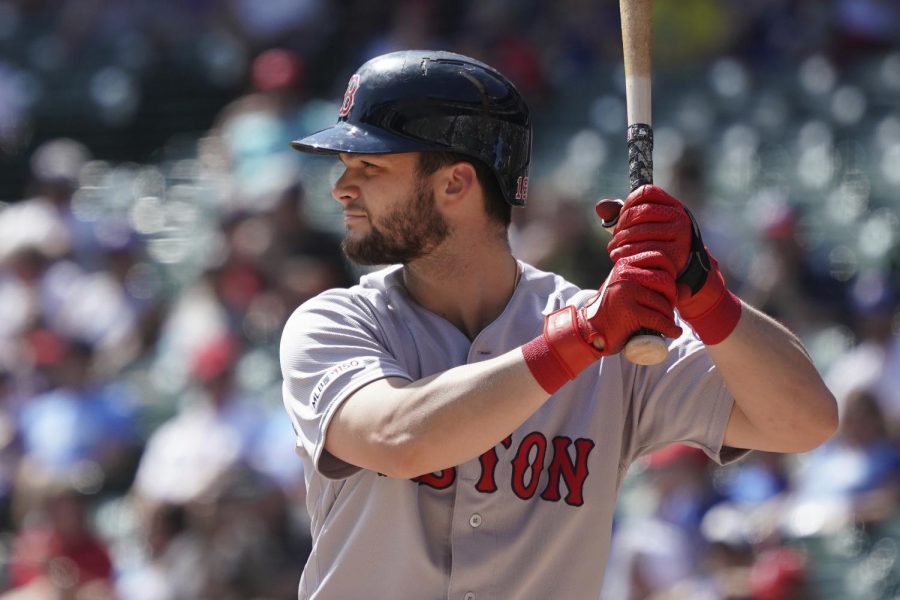Royals acquire Benintendi in trade with Red Sox, Mets
Then-Red Sox left fielder Andrew Benintendi takes an at-bat against the Texas Rangers on Sept. 29, 2019. Benintendi was acquired by the Royals on Feb. 11 to fill the hole in left field, as well as to provide a left-handed bat for the lineup.
February 18, 2021
The Kansas City Royals acquired the left-handed hitting outfielder that they have been looking for all offseason on Feb. 11, landing Andrew Benintendi from the Boston Red Sox in a three-way trade that also involved the New York Mets. The Royals traded their No. 8 prospect, Khalil Lee, to the Mets as well as Francy Cordero and two players to be named later to the Red Sox.
The Royals’ search for a lefty outfielder was a long one, as they had gone through numerous options, such as Michael Brantley, Joc Pedersen, Marwin Gonzalez, and Nick Markakis, but came up empty-handed until now. They also waited until less than a week before pitchers and catchers reported for Spring Training workouts, although this has become a much more frequent occurrence in the past few years.
Benintendi had been a reliable Major League-caliber bat over the first four years of his career, posting back-to-back seasons with 40 doubles. He scuffled in 2020 however, as in 14 games he hit a paltry .104 with only one extra-base hit. He likely will be seeing most of his time in left field with the departure of longtime left fielder Alex Gordon, though he does have some Major League experience in center field if the Royals need him there.
He also has obliterated the baseball at Kauffman Stadium, with a slash line of .485/.564/.848/1.413 at the stadium. That sample size is only in eight games, however, the significance of that is that the Royals have acquired two of the biggest Royals-killers in recent memory, as they signed first baseman Carlos Santana from the Cleveland Indians as well.
The big cost in this deal is sending Lee to the Mets, as he had long been touted as the outfielder of the Royals’ future and was knocking on the door of the big leagues coming into Spring Training. His bat had stalled a bit in recent years, hitting only .264 in 2019 with a decent .363 on-base percentage at Double-A Northwest Arkansas, but his main attraction is his speed, stealing nearly 60 bases during the year. Due to the entire 2020 minor league season being axed, he was not able to get in-game at-bats last year and that may be showing in his statistics in the Puerto Rican Winter League, as in the 2020-21 season with the Indios de Mayaguez, he has hit .196 with only a .622 on-base plus slugging percentage.
Lee’s strikeouts were also a big problem, as his 32.8% strikeout percentage rivals the most prolific strikeout hitters in the game; in fact, he set a professional baseball record by striking out an unheard of eight times in a 21-inning game in 2017. Still, the Royals were optimistic that he could make his Major League debut this year and contribute to a team with playoff aspirations.
Trading away Franchy Cordero is another puzzling decision, as he indeed fits what the Royals were looking for in a left-handed outfielder. He performed well enough in his lone season in Kansas City, as though he only hit .211, he put up great power numbers. Cordero only played 16 games due to a nagging wrist injury, marking the fourth consecutive season he has ended up on the disabled list at some point, so it’s fair to label him “injury-prone,” and giving up on him may not be the worst decision they could have made.
This trade caps off one of the most active offseasons the Royals have had in quite some time, as they have now acquired the likes of Benintendi, Santana, Hanser Alberto, Ervin Santana, Wade Davis, and Mike Minor. The Royals’ playoff aspirations are looking more realistic with each acquisition, which means that the rebuild is coming to an end.

